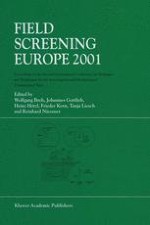"Field screening" indicates field analytical tools, and (quick) methods and strategies for on-site or in-situ environmental analysis and assessment of contamination. "Field screening" includes not only field analytical methods, such as mobile laboratories, portable analyses, detectors, sensors, or noninvasive techniques, but also reconnaissance strategies and problems of measurement in heterogeneous media, using, among others, new geotechnical and geophysical instruments.
This volume contains both oral and poster contributions to the Second International Conference on Strategies and Techniques for the Investigation and Monitoring of Contaminated Sites, "Field Screening Europe 2001", held in Karlsruhe, May 14 - May 16, 2001. As an integrated study of environmental contamination, "field screening" has become a more and more important part of environmental monitoring and the assessment of chemical contaminations. Recent developments are presented in these proceedings.
Audience: Environmental engineers, geo-scientists, chemists, biologists, soil scientists, hydrologists and geophysicists.
